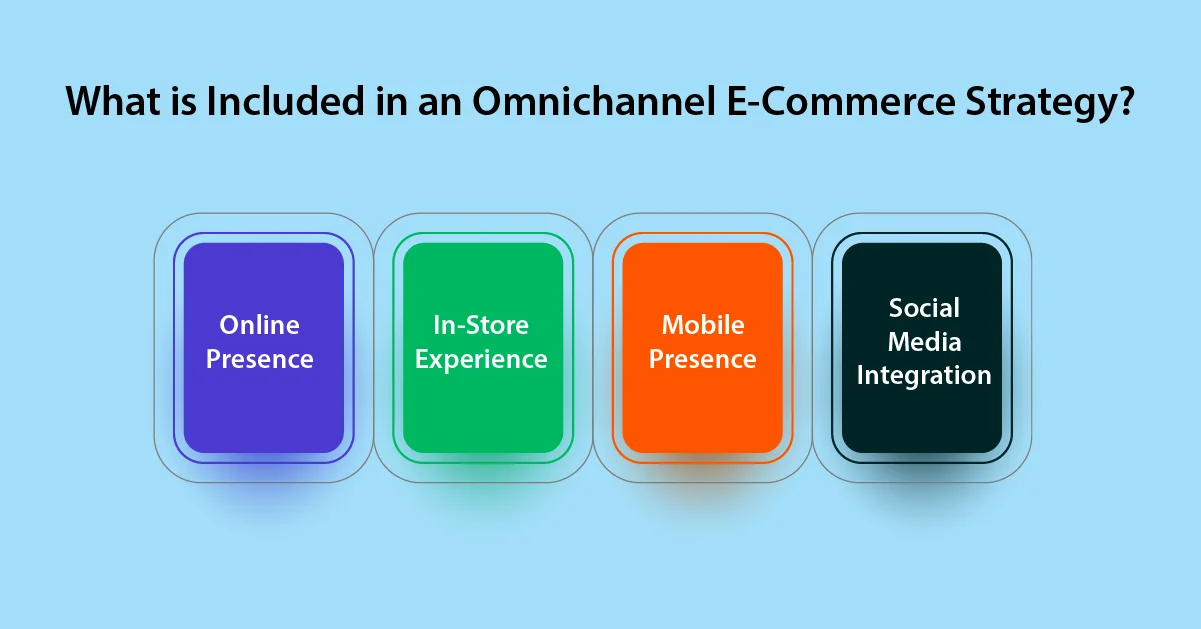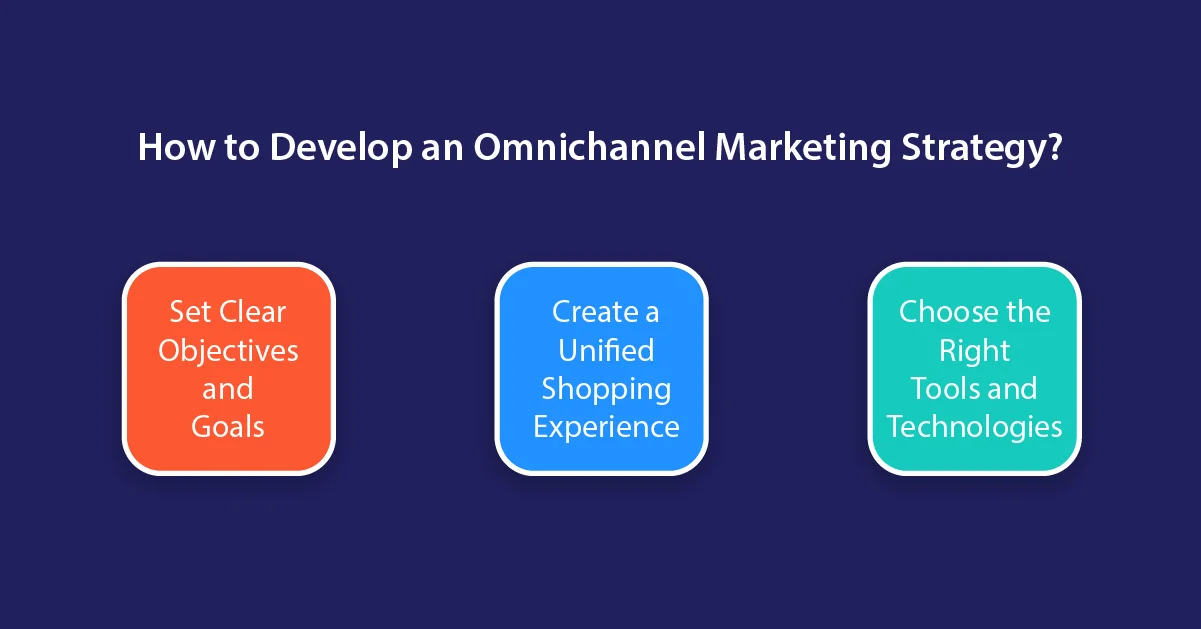Did you know that there are over 26.5 million e-commerce websites in operation today, with more being set up every day? This number serves not only as an indicator of the potential of e-commerce but also as the bellwether of intensifying competition in the space.
To withstand growing competition and adapt to emerging patterns in consumer behavior, leading brands across the globe are looking for newer ways to reach new customers and keep them engaged. And by far, the most impactful of these strategies has been the omnichannel e-commerce strategy implementation.
This Article Contains:
What is Omnichannel E-Commerce?
Put simply, omnichannel e-commerce is a way of selling products through different channels, like physical stores, websites, and mobile apps, all working together seamlessly. The idea is to create a smooth and connected experience for customers, no matter where they choose to shop.
For example, a customer might discover a brand of sneakers on a social media app like Instagram, try it out at a nearby physical store, and then finally buy it using that brand’s mobile app. Omnichannel marketing in e-commerce aims to make this process easy and enjoyable, ensuring that customers can switch between different ways of shopping without any hassles.
In addition to this, the ideal omnichannel experience also includes a series of data-driven, personalized micro-experiences (e.g., a one-time discount coupon) that nudge potential buyers towards conversion.
Is Omnichannel the Same as Multichannel Approach?
The terms omnichannel and multichannel do seem interchangeable. However, that’s not the case. To understand the difference, let’s understand what each term means:
-
Single-channel commerce: Single-channel commerce refers to businesses selling their products or services through one platform, like a physical store or an online website. It is a straightforward, singular focus on one avenue for transactions.
For example, a small local bakery that only sells its goods in a physical storefront without an online presence would be considered a single-channel commerce business.
-
Multichannel commerce: Multichannel commerce involves businesses selling their products or services through various independent channels. This can include physical stores, websites, social media platforms, and more. Each channel operates separately, and there may not be much coordination between them.
For instance, a company might sell items in a brick-and-mortar store and on a website, but these channels may not be interconnected. Multichannel commerce provides customers with different ways to make purchases, but the challenge lies in managing and coordinating these diverse channels effectively.
-
Omnichannel commerce: Omnichannel commerce is when businesses sell their products or services through various channels that work together seamlessly. Similar to multichannel, it includes physical stores, online websites, mobile apps, and more.
The key difference is that omnichannel enables customers to switch between different ways of shopping without any disruptions. For instance, a cross-platform cart that allows customers to add items to their shopping cart on the mobile app and seamlessly continue their purchase on the website, and vice versa.
So why is omnichannel important today? A Harvard Business Review study suggests that 73% of customers utilize multiple channels during their shopping journey. Retailers with a strong omnichannel presence can provide better service, and personalized experiences, and ultimately stand out in the competitive market by adapting to the diverse ways people like to shop.
What is Included in an Omnichannel E-Commerce Strategy?
As we explained, an omnichannel approach is where multiple channels are unified. An omnichannel marketing strategy is understanding how customers use various channels like online, in-store, mobile, and social media, and then creating a cohesive plan to reach and engage them across all these platforms. It includes the following:

1. Online Presence
There's no question about online shopping being popular today because of its convenience, accessibility, and increasing reliance on digital technologies. Online transactions are predicted to make up 24% of retail purchases by 2026.
Therefore, having a robust online presence remains crucial in an omnichannel marketing strategy. It allows businesses to connect with a broad audience that prefers to shop online, ensuring they don't miss out on potential customers. An online presence enables seamless integration with other channels like in-store and mobile, creating a unified experience for shoppers.
2. In-Store Experience
The in-store experience is also important in an omnichannel retail solution because it adds a personal touch to the customer journey. While online shopping provides convenience, the in-store experience allows customers to interact with products physically. Many consumers still prefer to see, touch, and feel products, as well as the social aspect of shopping with others.
A positive in-store experience contributes to overall customer satisfaction, making them more likely to choose and recommend the brand across various channels.
3. Mobile Presence
As of 2023, the number of smartphone users worldwide stood at around 6.92 billion. This represents over 86% of the global population. Leveraging this strong mobile presence, businesses can connect with customers wherever they are, providing a convenient way to browse products, make purchases, and engage with the brand.
This is especially important as many shoppers use their mobile devices while on the go. Integrating a mobile-friendly website or app into the overall strategy ensures a seamless experience. In fact, an increasing percentage of businesses are realizing the importance of mobile-first experiences to woo online shoppers. By embracing a mobile-first approach, businesses can tap into a large and growing market segment.
4. Social Media Integration
Did you know that an average user spends 2.5 hours per day on social media? Social media integration is important in an omnichannel marketing strategy because it can help businesses connect with customers on platforms where they spend a significant amount of time.
By maintaining an active presence on social media platforms like Facebook, Instagram, and Twitter, businesses engage with their audience, share content, and build better relationships. Furthermore, creating a seamless experience enables businesses to directly showcase and sell their products through their social media pages.
While having these channels is important, the essence of an omnichannel marketing strategy is consistency across them. Consistency in brand image, messages, and overall user experience in online channels, stores, and social media platforms enhances the brand's identity. Imagine if a brand is friendly on social media but feels different in a physical store; it might confuse customers.
Consistency builds trust and loyalty because customers know what to expect. It's like meeting an old friend who is always the same—reliable and true. This unified approach not only makes the brand more recognizable but also makes them a preferred option.
The omnichannel strategy has worked well for many retailers. Some of the examples are:
-
Amazon: Amazon has been a standout example of successful omnichannel marketing by blending its online presence with physical stores. Through its acquisition of Whole Foods and the introduction of Amazon Go, they've created a shopping experience that seamlessly connects both worlds.
Customers can smoothly switch from browsing products online to shopping in a physical store. The integration allows for convenient services like online ordering and in-store pick-up, making the shopping journey more flexible.
-
Sephora: Sephora's omnichannel retail solution is a widely recognized success. In 2018, Sephora brought together its digital and physical retail teams. The brand's mobile app uses location-based marketing to recognize when a consumer enters their store, providing relevant information, store maps, and deals.
Sephora's in-store experience is supported by technology, with makeup artists using iPads and other mobile devices to showcase products and provide personalized recommendations. The brand has also introduced mobile-enabled experiences, such as browsing products on in-store iPad stations and scheduling appointments via the mobile app.
-
Disney: Disney knows its audience long before it gets to the parks through its content, which includes some of the biggest names, from Pixar to Star Wars and Marvel. The company has implemented MyMagic+, an omnichannel ecommerce platform that merges the digital and physical worlds.
It ensures customers get the most from their experience by interacting with them through a single, convenient channel. The platform allows visitors to pay for everything by pressing 'Mickey to Mickey,' leading to ease of use and a higher propensity to spend. It has mobile-enabled experiences, such as browsing products on in-store stations and scheduling appointments via the mobile app.
Looking at these examples, you might be wondering how to create omnichannel e-commerce solutions of your own. Well, we are here to help you with that. However, it's important to assess your current state first.
Evaluating Present Resources
You may already have single-channel or multichannel assets. So the first thing you can do is do a simple SWOT analysis to assess your assets and build your omnichannel e-commerce solutions.
1. Strengths
These refer to the different assets that your retail business already possesses, which can be used as the starting point for building your omnichannel presence. Examples of strengths include:
Physical Presence: Already has a brick-and-mortar store, providing a tangible touchpoint for customers.
Existing E-commerce Website: The basic e-commerce website establishes an initial online presence.
2. Weaknesses
Weaknesses within the context of omnichannel e-commerce refer to parts of your customer journey that are not well integrated with each other, leading to a poor shopping experience. This can include:
Limited Online Features: The current e-commerce website may lack advanced features for a seamless online experience.
Lack of centralization: Multiple brick-and-mortar outlets may operate independently, potentially causing a disjointed customer journey.
3. Opportunities
E-commerce players can leverage evolving consumer behavior and other economic factors to expand their omnichannel capabilities.
Enhanced Online Platforms: Improving the e-commerce website with user-friendly features and mobile optimization.
Integrated Loyalty Programs: Implementing a unified loyalty program that works both in-store and online.
4. Threats
There can be things outside of your control that will be accounted for while planning your omnichannel network, ranging from changing customer needs to supply chain disruptions. A few examples of threats include:
Competitive Online Market: Facing competition from other online retailers in the digital space.
Customer Expectations: Failing to meet evolving customer expectations for a seamless shopping experience.
Being aware of the status quo will help to implement your omnichannel e-commerce strategy more efficiently.
How to Develop an Omnichannel Marketing Strategy?
Once you know the strengths and weaknesses of your business channels, the next step is to create a complete omnichannel strategy. This means planning how your physical store and online presence will work together seamlessly. Here are some steps to create the best omnichannel e-commerce strategy for your brand.

1. Set Clear Objectives and Goals
Setting clear objectives and goals is crucial in building an omnichannel marketing strategy. While this is a well-known step, many businesses skip it or don’t do it thoroughly. It’s like having a map for your journey.
Without clear goals, it’s difficult to measure success. Taking the time to set specific objectives ensures that every part of the omnichannel plan is aligned toward a common purpose. This makes it easier to track progress and make adjustments as needed.
Let’s take the example of Store A to see how setting clear goals and objectives looks like.
Store A wants to enhance its website. One way to do so is by integrating engaging visual content that adds consistency to branding. So the goal could be to include high-quality images, informative videos, and 360-degree views, to provide customers with a more immersive and informative view of the products.
Now the objectives could look like this:
Setting a budget for procuring high-quality images, videos, and 360-degree views of products.
Finding an able team of photographers and videographers.
Creating content that aligns with the branding.
Setting deadlines for uploading the content.
Ensuring the website loading speed is not affected by optimizing the content.
Creating additional content like product descriptions.
This can be one of the goals for creating an omnichannel e-commerce experience.
2. Create a Unified Shopping Experience
As we have mentioned before, a unified shopping experience is the heart and soul of omnichannel marketing. Businesses can take several measures to provide a seamless shopping experience.
For instance, Store A can include real-time inventory visibility for customers.
Real-time inventory visibility will enable customers to see if a product is in stock right when they're browsing online. Additionally, it can inform customers about stock availability in nearby stores making it easier for them to choose between shopping online or visiting a physical store.
To maintain consistency, Store A can integrate product catalog synchronization. This ensures that product catalogs are consistent and up-to-date between the mobile app and website. Any changes or additions to products will be reflected on both platforms.
By integrating these elements, Store A can offer a seamless and cohesive shopping journey for customers, whether they choose to shop online or in-store.
And do you know what else would make the customers happy and boost loyalty? The answer is integrated loyalty programs.
Why are loyalty programs widely embraced by customers?
Customers appreciate integrated loyalty programs and omnichannel promotions because they make the whole shopping experience more rewarding. When loyalty programs and promotions work across different channels, customers can earn and redeem rewards seamlessly, no matter where they shop.
Cross-channel loyalty programs not only save customers the hassle of managing multiple loyalty cards but also make them feel valued and appreciated. Integrated programs also allow businesses to gather better insights into customer preferences and behavior. This can help businesses to offer more personalized rewards and incentives.
Loyalty programs can be divided into four sections:
Points-based Loyalty Programs: In points-based loyalty programs, customers earn points for every purchase. These points accumulate over time and can be redeemed for rewards or discounts.
Value-based Loyalty Programs: Value-based programs focus on rewarding customers with exclusive discounts, special offers, or personalized deals based on their spending habits.
Tiered Loyalty Programs: Tiered programs categorize customers into different levels or tiers based on their loyalty and engagement. As customers move up the tiers, they unlock more benefits, such as exclusive access, enhanced rewards, or personalized services. It's a structured way to acknowledge and reward varying levels of loyalty within a customer base.
Subscription-based Loyalty Programs: Subscription-based programs involve customers paying a regular fee to access premium benefits and perks. This approach fosters a sense of exclusivity and commitment, as subscribers enjoy ongoing privileges, like free shipping, early access to sales, or exclusive content.
You can choose a loyalty program type based on your customer behavior and how your business operates. For instance, if you sell a lot of repeat-purchase items like grocery, points-based or tiered programs could work. If your customers enjoy exclusive deals, a value-based program might be the way to go.
Make sure you look at the long-term benefits for both you and your customers. Will the program keep them coming back? Does it align with your business goals? A good loyalty program should be a win-win for everyone.
Choose the Right Tools and Technologies
In today's world, using the right tools and technologies is crucial for seamlessly integrating all the marketing and sales channels. These tools help both the businesses and the customers. For a business owner, it means they can manage everything more efficiently, while for customers, it ensures a smooth and connected experience no matter how they interact with the business.
To create an omnichannel experience, here are some of the technologies you should consider:
-
Point of Sale (POS) Systems
A Point of Sale (POS) system is a technology that facilitates transactions and manages sales in businesses. Modern POS systems act like the control center where all sales transactions are managed, whether they happen in-store or online.Think of it as the heart of the operation. With an effective POS system, businesses can keep track of inventory, process orders, and handle payments seamlessly, ensuring that the information is consistent across all channels. It not only makes things easier for the business but also provides customers with a reliable and unified shopping experience.
When choosing a Point of Sale (POS) system for your business, consider options like Magestore, Square, Lightspeed, and many others available in the market. Evaluate each system based on your business needs and ensure to check all the features they offer. It's important to select a POS system that aligns with your specific business requirements.
-
Customer Relationship Management Software (CRMS)
Customer Relationship Management Systems (CRMS) are software that helps businesses manage their interactions and relationships with customers. These systems typically store customer information, track communication history, and provide insights to enhance customer experience.With this information, businesses can personalize the shopping experience, offer targeted promotions, and better understand their customers' needs.
CRM systems also enable consistent communication, ensuring that customers receive the same level of service and information, whether they interact with the business through the website, social media, or in person.
According to Finances Online, CRM systems can increase customer satisfaction by 74%, improve productivity by 50%, and boost sales by 87%. If the benefits of CRM do not appeal to you then you should also consider how not integrating it can affect your business.
The absence of a CRM system can lead to unorganized customer data, making it difficult to manage and retrieve important information. This lack of organization affects customer engagement, as businesses may struggle to understand customer preferences, resulting in generic communication.
Decision-making suffers without the insights provided by a CRM, leading to less effective strategies. Customer relationships can also be strained due to a lack of timely responses and personalization, impacting the overall reputation of the business.
-
E-commerce Platforms
E-commerce platforms are software solutions that provide businesses with the tools and infrastructure needed to conduct online transactions and manage various aspects of their digital storefronts. These platforms offer a range of features, including product listing, inventory management, payment processing, and order fulfillment.E-commerce platforms play a crucial role in enabling businesses to create and operate online stores. They facilitate the buying and selling of goods and services over the Internet. They are designed to streamline the e-commerce process, providing a user-friendly interface for both businesses and customers while supporting the technical requirements essential for online transactions.
Businesses must consider several factors before selecting an e-commerce platform.
Scalability: The platform should be able to support growth as the business gets bigger. Meaning it should handle more customers and transactions without any issues.
Flexibility: It should have flexibility with many customization options to align with the branding needs.
Integration: It should seamlessly connect with other tools like payment gateways and inventory management systems to ensure smooth functioning between different business processes.
User-friendliness: It should be easy to navigate for both administrators and customers.
Security: The platform should have robust security features to safeguard customer data and ensure compliance with industry standards.
Cost: The cost of the platform, factoring in both initial setup expenses and ongoing maintenance fees, should align with the business’s budget.
By carefully weighing these considerations, businesses can make an informed decision and choose an e-commerce platform that best suits their requirements and supports a successful online presence.
Popular examples of e-commerce platforms include Shopify, WooCommerce, Magento, and BigCommerce.
How to Build a Strong Online Presence?
Today, consumers increasingly rely on online channels for product research, reviews, and purchases. Consumers are no longer limited to just two touch points per purchase; the average has now tripled to six.
A strong online presence not only enhances a brand's visibility but also provides a convenient and accessible platform to engage customers. It acts as the digital storefront that aligns with in-store interactions. This presence is crucial for a successful omnichannel e-commerce strategy, as it enables businesses to connect with customers across various touchpoints, including websites, social media, and mobile apps.
1. Invest in a Functional Website
For a strong online presence, your website needs to check out all the foundational features required today. If you already have a website, here are some things you can do to improve it:
-
User-Friendly Interface
How would you increase your website's conversion rate by 200%? That's what a well-designed user interface does according to Forrester research. A user-friendly interface on an e-commerce website means it's designed to be easy to use and navigate. For many online shoppers today, especially the younger generation, having a simple website is crucial.Consumers prefer a simple and fast shopping experience when they purchase online. That's because they have a shorter attention span, meaning they don't want to spend a lot of time figuring out how to use a website.
The challenge is to grab the consumer's attention without overwhelming them with too much information. This involves presenting the most important details in a visually appealing way, using engaging images and concise descriptions.
The goal is to make the shopping experience enjoyable and efficient. A user-friendly interface combines simplicity, clarity, and visually interesting elements to make the online shopping journey smooth and enjoyable.
-
Mobile Responsiveness
A Statista report reveals that 60% of global e-commerce sales are attributed to mobile devices. A good mobile-responsive design involves optimizing the website for various screen sizes and ensuring seamless functionality on smartphones and tablets. This includes elements like flexible layouts, easy navigation through touch, and appropriately sized buttons for touchscreen interactions.Visuals and text are adjusted to fit smaller screens, and load times are optimized for quicker access. The goal is to provide users with a consistent and user-friendly experience regardless of the device they use.
As customers increasingly switch between devices during their shopping journey, a seamless transition from desktop to mobile ensures continuity. For instance, a customer might explore products on their desktop at home, add items to their cart on a tablet while commuting, and then make the final purchase on their smartphone.
A well-executed mobile-responsive design facilitates this omnichannel flow, allowing users to pick up where they left off on another device.
-
Secure Payment Gateways
A secure payment gateway is crucial for protecting sensitive customer information during online transactions, ensuring a safe and trustworthy payment process.To integrate a secure payment gateway, businesses should select a reputable payment service provider and follow best practices. This includes implementing encryption, using secure and up-to-date protocols, and complying with Payment Card Industry Data Security Standard (PCI DSS) requirements.
Regular security audits and monitoring for potential vulnerabilities are essential for maintaining a robust defense against cyber threats.
The absence of a secure payment gateway can severely affect a business. Customers may be reluctant to share their payment details, leading to a loss of trust and potential abandonment of the purchase. Data breaches can lead to financial losses, damage to reputation, and legal consequences.
For example, in July 2018, a cyberattack on SHEIN led to the exposure of customer payment details. The breach was caused by a vulnerability in SHEIN's payment system, leading to a significant impact on both its finances and brand reputation.
2. Implement Search Engine Optimization (SEO) Strategies
SEO plays an important role in boosting e-commerce sales by enhancing the online visibility of an e-commerce store in search engine results. This increased visibility attracts more visitors, leading to a higher conversion rate and more sales. According to a study, organic search, which is a result of effective SEO, drives over half (53.3%) of all website traffic.
Improving the SEO of an e-commerce website involves several key strategies. Here are some actionable steps:
Keyword Research: This includes identifying relevant keywords for your products and industry.
Optimize Product Descriptions: Here, you can write unique, compelling, and informative product descriptions. Make sure you include relevant keywords naturally in product descriptions.
Optimize On-Page Elements: This involves optimizing title tags, meta descriptions, and header tags with target keywords.
Mobile Optimization: Ensuring your e-commerce site is mobile-friendly comes under good SEO practices. Google gives importance to mobile-friendly websites in search results.
Page Speed Optimization: This involves optimizing images and using compression to improve page loading times. Improved loading speed of pages enhances user experience and boosts SEO rankings.
User-friendly URL Structure: This refers to creating a clear and logical URL structure for easy navigation.
High-Quality Content: This involves producing high-quality, relevant, and engaging content. It also refers to regularly updating content to keep it fresh and valuable.
Internal Linking: This refers to using internal links to connect related pages on your site. Internal links improve site navigation and distribute page authority.
By implementing these strategies, e-commerce websites can enhance their SEO, and attract more organic traffic.
3. Utilize Social Media Platforms
The impact of social media on e-commerce cannot be ignored. It provides a direct channel for businesses to connect with their audience. Platforms like Facebook, Instagram, X (Twitter), and Linkedin offer opportunities to showcase products, share business updates, and interact with customers.
One of the best examples of utilizing social media is social selling.
Social selling involves using social media platforms to connect, interact, and establish relationships with potential customers as part of a sales strategy. Unlike traditional sales approaches, social selling is centered around establishing a strong online presence, actively participating in social communities, and providing valuable content to attract and nurture leads.
Take Airbnb for example. It uses social media platforms like Facebook and Instagram to let people share pictures of the places they stay in. It's not just ads; it's real people sharing their experiences, making it more genuine and interesting for potential customers.
By building trust and credibility through authentic interactions, social selling aims to convert social media connections into loyal customers.
Enhancing In-Store and Digital Experiences
A positive in-store experience, complementing digital interactions, helps facilitate stronger customer engagement. Engaging in in-person interactions, personalized assistance, and the ability to physically try products contribute to a memorable experience.
This enhances customer loyalty as shoppers are more likely to return to a retailer that provides a consistently enjoyable and convenient shopping environment.
To create an omnichannel experience, it is important to build a cohesive e-commerce environment that includes both in-store and digital experiences. To do so, businesses can choose services like:
1. Click-and-Collect Services
Click-and-collect allows customers to make purchases online and then pick up their items at a physical store. This service combines the ease of online shopping with the quick access to in-store pickup.
This helps customers to save on shipping costs and reduce delivery times. Businesses can also include other order fulfillment options like buy online, pick up in-store (BOPIS), ship from store, or home delivery, enhancing overall customer experience.
2. Buy Online, Return In-Store (BORIS)
BORIS options enable customers to make returns at a physical store for items purchased online. This approach simplifies the return process and provides customers with a hassle-free way to manage returns without the need for shipping.
This not only streamlines the return process but also creates a bridge between the online and in-store shopping experiences, reinforcing customer engagement.
3. Modern In-Store Technology
Incorporating cutting-edge in-store technology supports customers in making quicker and well-informed decisions. Here are some of the contemporary technologies you can integrate into your physical store to enhance the overall shopping experience.
Smart POS Systems: Implementing Smart POS systems modernizes the checkout process. These systems streamline transactions, accept various payment methods, and provide real-time inventory updates. Smart POS systems reduce wait times for customers and enable seamless integration with other digital channels.
Interactive Displays: Interactive displays facilitate product exploration and information gathering within the store. Touchscreen displays and interactive kiosks engage customers, offering detailed product information, reviews, and recommendations. These displays enhance the overall in-store experience, allowing customers to interact with products in a digital space, making the shopping journey more dynamic and enjoyable.
-
Augmented Reality (AR) and Virtual Reality (VR) Experiences: AR and VR create an immersive experience for in-store interactions. AR applications can enable customers to visualize products in their real-world environment before making a purchase decision.
Similarly, VR experiences can take customers to virtual environments, allowing them to explore products or services in a unique and interactive way. These technologies not only engage customers but also contribute to informed decision-making, creating memorable and immersive shopping experiences.
As consumers navigate seamlessly across various channels with an array of tools at their disposal, the need for a cohesive and integrated approach has become crucial. From mobile apps to social media websites, businesses across the globe are providing customers with a seamless shopping experience. To stay competitive in this environment, it’s important to build an effective omnichannel presence.
The foundational points discussed in this blog serve as essential building blocks for successfully integrating an omnichannel e-commerce strategy. However, note that these insights merely scratch the surface of the omnichannel approach. Stay tuned for our next blog, where we delve into advanced factors that will further elevate your omnichannel e-commerce strategy.
If you’re a retailer or a business looking to take the next step toward building your omnichannel ecommerce solutions, it is important to get the right combination of strategy, technology, and executional expertise. Having helped multiple businesses scale their operations digitally, Mayura Consultancy Services can help you on your omnichannel e-commerce growth journey.
FAQs
1. What is omnichannel marketing in e-commerce?
Omnichannel marketing in ecommerce involves seamlessly integrating online and offline channels to provide a unified shopping experience.
2. How can omnichannel marketing enhance customer experience?
Omnichannel marketing enables customers to interact with the brand across multiple channels creating a consistent and convenient buying journey.
3. What are the key channels in e-commerce omnichannel marketing?
The key channels in omnichannel marketing include a website, mobile apps, social media platforms, emails, SMS, and even physical stores.
4. What role does mobile play in omnichannel marketing?
Mobile plays a crucial role as it’s often the primary device for online shopping. Businesses should ensure that they have mobile-friendly websites and responsive designs, and they should consider developing dedicated mobile apps.
5. Can social media be effectively integrated into omnichannel strategies?
Yes, social media can play a significant role since it can be leveraged for advertising, customer engagement, and even direct selling with the help of influencers.







Comments
Share Your Feedback
Your email address will not be published. Required fields are marked *